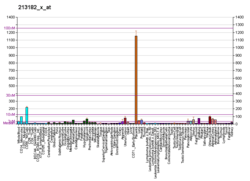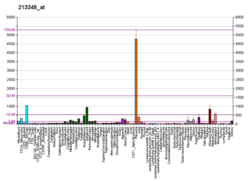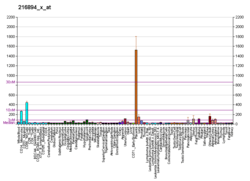Cyclin-dependent kinase inhibitor 1C
Cyclin-dependent kinase inhibitor 1C (p57, Kip2), also known as CDKN1C, is protein which in humans is encoded by the CDKN1C imprinted gene.[3]
Function
Cyclin-dependent kinase inhibitor 1C is a tight-binding inhibitor of several G1 cyclin/Cdk complexes and a negative regulator of cell proliferation. Mutations of CDKN1C are implicated in sporadic cancers and Beckwith-Wiedemann syndrome suggesting that it is a tumor suppressor candidate.[3]
CDKN1C is a tumor suppressor human gene on chromosome 11 (11p15) and belongs to the cip/kip gene family. It encodes a cell cycle inhibitor that binds to G1 cyclin-CDK complexes.[4] Thus p57KIP2 causes arrest of the cell cycle in G1 phase.
Clinical significance
A mutation of this gene may lead to loss of control over the cell cycle leading to uncontrolled cellular proliferation. p57KIP2 has been associated with Beckwith-Wiedemann syndrome (BWS) which is characterized by increased risk of tumor formation in childhood.[5] Loss-of-function mutations in this gene have also been shown associated to the IMAGe syndrome (Intrauterine growth restriction, Metaphyseal dysplasia, Adrenal hypoplasia congenita, and Genital anomalies).[6] Complete hydatidiform moles consist only of paternal DNA, and thus the cells lack p57 expression as the gene is paternally imprinted (silenced). Immuohistochemical stains for p57 can aid with the diagnosis of hydatidiform moles [7]
Interactions
Cyclin-dependent kinase inhibitor 1C has been shown to interact with:
References
- 1 2 3 ENSG00000129757 GRCh38: Ensembl release 89: ENSG00000273707, ENSG00000129757 - Ensembl, May 2017
- ↑ "Human PubMed Reference:".
- 1 2 "Entrez Gene: CDKN1C cyclin-dependent kinase inhibitor 1C (p57, Kip2)".
- ↑ Matsuoka S, Edwards MC, Bai C, Parker S, Zhang P, Baldini A, Harper JW, Elledge SJ (Mar 1995). "p57KIP2, a structurally distinct member of the p21CIP1 Cdk inhibitor family, is a candidate tumor suppressor gene". Genes & Development. 9 (6): 650–62. doi:10.1101/gad.9.6.650. PMID 7729684.
- ↑ Hatada I, Nabetani A, Morisaki H, Xin Z, Ohishi S, Tonoki H, Niikawa N, Inoue M, Komoto Y, Okada A, Steichen E, Ohashi H, Fukushima Y, Nakayama M, Mukai T (Oct 1997). "New p57KIP2 mutations in Beckwith-Wiedemann syndrome". Human Genetics. 100 (5–6): 681–3. doi:10.1007/s004390050573. PMID 9341892.
- ↑ Riccio A, Cubellis MV (Jul 2012). "Gain of function in CDKN1C". Nature Genetics. 44 (7): 737–8. doi:10.1038/ng.2336. PMID 22735584.
- ↑ LeGallo, Robin D.; Stelow, Edward B.; Ramirez, Nilsa C.; Atkins, Kristen A. (2008-05-01). "Diagnosis of hydatidiform moles using p57 immunohistochemistry and HER2 fluorescent in situ hybridization". American Journal of Clinical Pathology. 129 (5): 749–755. doi:10.1309/7XRL378C22W7APBT. ISSN 0002-9173. PMID 18426735.
- ↑ Yokoo T, Toyoshima H, Miura M, Wang Y, Iida KT, Suzuki H, Sone H, Shimano H, Gotoda T, Nishimori S, Tanaka K, Yamada N (Dec 2003). "p57Kip2 regulates actin dynamics by binding and translocating LIM-kinase 1 to the nucleus". The Journal of Biological Chemistry. 278 (52): 52919–23. doi:10.1074/jbc.M309334200. PMID 14530263.
- ↑ Joaquin M, Watson RJ (Nov 2003). "The cell cycle-regulated B-Myb transcription factor overcomes cyclin-dependent kinase inhibitory activity of p57(KIP2) by interacting with its cyclin-binding domain". The Journal of Biological Chemistry. 278 (45): 44255–64. doi:10.1074/jbc.M308953200. PMID 12947099.
- ↑ Reynaud EG, Leibovitch MP, Tintignac LA, Pelpel K, Guillier M, Leibovitch SA (Jun 2000). "Stabilization of MyoD by direct binding to p57(Kip2)". The Journal of Biological Chemistry. 275 (25): 18767–76. doi:10.1074/jbc.M907412199. PMID 10764802.
- ↑ Watanabe H, Pan ZQ, Schreiber-Agus N, DePinho RA, Hurwitz J, Xiong Y (Feb 1998). "Suppression of cell transformation by the cyclin-dependent kinase inhibitor p57KIP2 requires binding to proliferating cell nuclear antigen". Proceedings of the National Academy of Sciences of the United States of America. 95 (4): 1392–7. doi:10.1073/pnas.95.4.1392. PMC 19016. PMID 9465025.
Further reading
- Seizinger BR (Dec 1991). "Genes associated with tumor suppression and growth control in the human nervous system". Cancer Metastasis Reviews. 10 (4): 281–7. doi:10.1007/BF00554790. PMID 1786629.
- Lee MH, Reynisdóttir I, Massagué J (Mar 1995). "Cloning of p57KIP2, a cyclin-dependent kinase inhibitor with unique domain structure and tissue distribution". Genes & Development. 9 (6): 639–49. doi:10.1101/gad.9.6.639. PMID 7729683.
- Matsuoka S, Edwards MC, Bai C, Parker S, Zhang P, Baldini A, Harper JW, Elledge SJ (Mar 1995). "p57KIP2, a structurally distinct member of the p21CIP1 Cdk inhibitor family, is a candidate tumor suppressor gene". Genes & Development. 9 (6): 650–62. doi:10.1101/gad.9.6.650. PMID 7729684.
- Matsuoka S, Thompson JS, Edwards MC, Bartletta JM, Grundy P, Kalikin LM, Harper JW, Elledge SJ, Feinberg AP (Apr 1996). "Imprinting of the gene encoding a human cyclin-dependent kinase inhibitor, p57KIP2, on chromosome 11p15". Proceedings of the National Academy of Sciences of the United States of America. 93 (7): 3026–30. doi:10.1073/pnas.93.7.3026. PMC 39755. PMID 8610162.
- Reid LH, Crider-Miller SJ, West A, Lee MH, Massagué J, Weissman BE (Mar 1996). "Genomic organization of the human p57KIP2 gene and its analysis in the G401 Wilms' tumor assay". Cancer Research. 56 (6): 1214–8. PMID 8640800.
- Tokino T, Urano T, Furuhata T, Matsushima M, Miyatsu T, Sasaki S, Nakamura Y (May 1996). "Characterization of the human p57KIP2 gene: alternative splicing, insertion/deletion polymorphisms in VNTR sequences in the coding region, and mutational analysis". Human Genetics. 97 (5): 625–31. doi:10.1007/BF02281873. PMID 8655143.
- Hatada I, Ohashi H, Fukushima Y, Kaneko Y, Inoue M, Komoto Y, Okada A, Ohishi S, Nabetani A, Morisaki H, Nakayama M, Niikawa N, Mukai T (Oct 1996). "An imprinted gene p57KIP2 is mutated in Beckwith-Wiedemann syndrome". Nature Genetics. 14 (2): 171–3. doi:10.1038/ng1096-171. PMID 8841187.
- Furuhata T, Tokino T, Urano T, Nakamura Y (Nov 1996). "Isolation of a novel GPI-anchored gene specifically regulated by p53; correlation between its expression and anti-cancer drug sensitivity". Oncogene. 13 (9): 1965–70. PMID 8934543.
- LaBaer J, Garrett MD, Stevenson LF, Slingerland JM, Sandhu C, Chou HS, Fattaey A, Harlow E (Apr 1997). "New functional activities for the p21 family of CDK inhibitors". Genes & Development. 11 (7): 847–62. doi:10.1101/gad.11.7.847. PMID 9106657.
- Watanabe H, Pan ZQ, Schreiber-Agus N, DePinho RA, Hurwitz J, Xiong Y (Feb 1998). "Suppression of cell transformation by the cyclin-dependent kinase inhibitor p57KIP2 requires binding to proliferating cell nuclear antigen". Proceedings of the National Academy of Sciences of the United States of America. 95 (4): 1392–7. doi:10.1073/pnas.95.4.1392. PMC 19016. PMID 9465025.
- Bhuiyan ZA, Yatsuki H, Sasaguri T, Joh K, Soejima H, Zhu X, Hatada I, Morisaki H, Morisaki T, Mukai T (Mar 1999). "Functional analysis of the p57KIP2 gene mutation in Beckwith-Wiedemann syndrome". Human Genetics. 104 (3): 205–10. doi:10.1007/s004390050937. PMID 10323243.
- Lam WW, Hatada I, Ohishi S, Mukai T, Joyce JA, Cole TR, Donnai D, Reik W, Schofield PN, Maher ER (Jul 1999). "Analysis of germline CDKN1C (p57KIP2) mutations in familial and sporadic Beckwith-Wiedemann syndrome (BWS) provides a novel genotype-phenotype correlation". Journal of Medical Genetics. 36 (7): 518–23. doi:10.1136/jmg.36.7.518. PMC 1734395. PMID 10424811.
- Reynaud EG, Leibovitch MP, Tintignac LA, Pelpel K, Guillier M, Leibovitch SA (Jun 2000). "Stabilization of MyoD by direct binding to p57(Kip2)". The Journal of Biological Chemistry. 275 (25): 18767–76. doi:10.1074/jbc.M907412199. PMID 10764802.
- Fink JR, LeBien TW (Apr 2001). "Novel expression of cyclin-dependent kinase inhibitors in human B-cell precursors". Experimental Hematology. 29 (4): 490–8. doi:10.1016/S0301-472X(01)00619-1. PMID 11301189.
- Kido K, Doerks A, Lochelt M, Flügel RM (Apr 2002). "Identification and functional characterization of an intragenic DNA binding site for the spumaretroviral trans-activator in the human p57Kip2 gene". The Journal of Biological Chemistry. 277 (14): 12032–9. doi:10.1074/jbc.M108747200. PMID 11815601.
- Balint E, Phillips AC, Kozlov S, Stewart CL, Vousden KH (Mar 2002). "Induction of p57(KIP2) expression by p73beta". Proceedings of the National Academy of Sciences of the United States of America. 99 (6): 3529–34. doi:10.1073/pnas.062491899. PMC 122557. PMID 11891335.
- Ito Y, Yoshida H, Nakano K, Kobayashi K, Yokozawa T, Hirai K, Matsuzuka F, Matsuura N, Kuma K, Miyauchi A (Apr 2002). "Expression of p57/Kip2 protein in normal and neoplastic thyroid tissues". International Journal of Molecular Medicine. 9 (4): 373–6. doi:10.3892/ijmm.9.4.373. PMID 11891530.
- Kikuchi T, Toyota M, Itoh F, Suzuki H, Obata T, Yamamoto H, Kakiuchi H, Kusano M, Issa JP, Tokino T, Imai K (Apr 2002). "Inactivation of p57KIP2 by regional promoter hypermethylation and histone deacetylation in human tumors". Oncogene. 21 (17): 2741–9. doi:10.1038/sj.onc.1205376. PMID 11965547.
- Li Y, Nagai H, Ohno T, Yuge M, Hatano S, Ito E, Mori N, Saito H, Kinoshita T (Oct 2002). "Aberrant DNA methylation of p57(KIP2) gene in the promoter region in lymphoid malignancies of B-cell phenotype". Blood. 100 (7): 2572–7. doi:10.1182/blood-2001-11-0026. PMID 12239171.
External links
- GeneReviews/NIH/NCBI/UW entry on Beckwith-Wiedemann Syndrome
- CDKN1C human gene location in the UCSC Genome Browser.
- CDKN1C human gene details in the UCSC Genome Browser.




